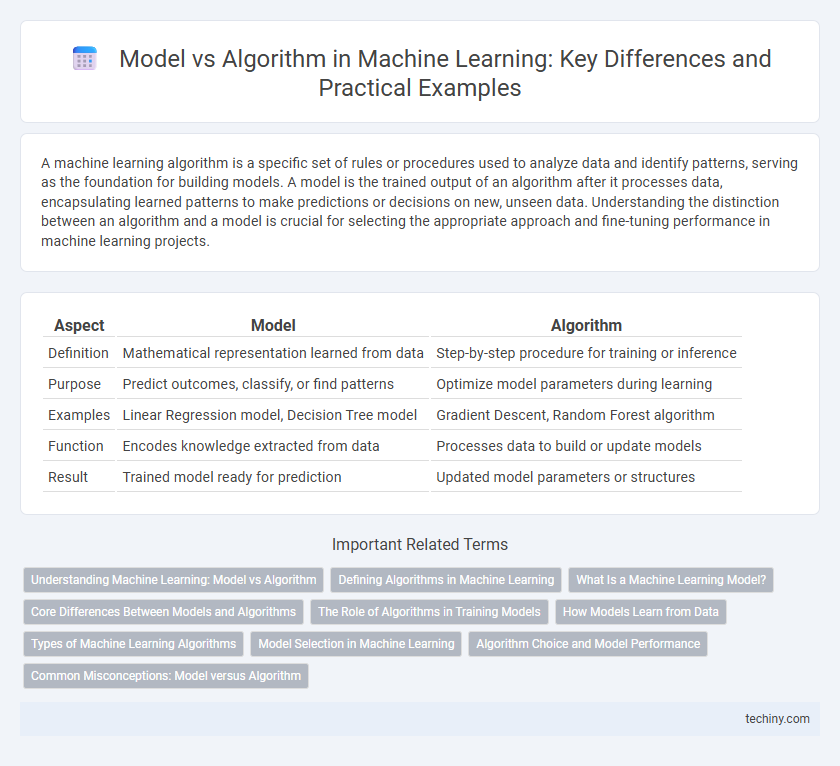A machine learning algorithm is a specific set of rules or procedures used to analyze data and identify patterns, serving as the foundation for building models. A model is the trained output of an algorithm after it processes data, encapsulating learned patterns to make predictions or decisions on new, unseen data. Understanding the distinction between an algorithm and a model is crucial for selecting the appropriate approach and fine-tuning performance in machine learning projects.
Table of Comparison
| Aspect | Model | Algorithm |
|---|---|---|
| Definition | Mathematical representation learned from data | Step-by-step procedure for training or inference |
| Purpose | Predict outcomes, classify, or find patterns | Optimize model parameters during learning |
| Examples | Linear Regression model, Decision Tree model | Gradient Descent, Random Forest algorithm |
| Function | Encodes knowledge extracted from data | Processes data to build or update models |
| Result | Trained model ready for prediction | Updated model parameters or structures |
Understanding Machine Learning: Model vs Algorithm
A machine learning algorithm is a set of mathematical instructions designed to find patterns in data and make predictions or decisions, while a model is the trained output created by applying an algorithm to a specific dataset. Algorithms like linear regression, decision trees, or neural networks define the learning process, whereas models represent the learned relationships and parameters tuned during training. Understanding the distinction between model and algorithm is crucial for optimizing performance, selecting appropriate techniques, and interpreting results in machine learning projects.
Defining Algorithms in Machine Learning
Algorithms in machine learning are step-by-step computational procedures designed to analyze data, identify patterns, and make predictions or decisions without explicit programming. They serve as the foundation for building models by defining how input data is transformed into meaningful outputs through mathematical functions and optimization techniques. Key examples include decision trees, support vector machines, and neural networks, each tailored for specific types of data and tasks.
What Is a Machine Learning Model?
A machine learning model is a mathematical representation trained on data to recognize patterns and make predictions or decisions without explicit programming. It encapsulates the learned parameters and structures derived from algorithms, enabling tasks like classification, regression, and clustering. Unlike algorithms, which provide the procedure for learning, models are the output that directly applies insights to new, unseen data.
Core Differences Between Models and Algorithms
Models represent the trained output that makes predictions or decisions based on input data, whereas algorithms are the systematic procedures or sets of rules used to train these models. Algorithms like gradient descent or decision trees define the method to optimize and adjust parameters during training, while models embody the learned patterns or relationships derived from this process. Understanding this distinction is essential for selecting the appropriate approach in machine learning tasks and improving model performance.
The Role of Algorithms in Training Models
Algorithms serve as the foundational procedures in machine learning that enable models to learn from data by optimizing parameters through iterative processes like gradient descent. These algorithms define how input data is transformed into meaningful patterns, guiding the model to minimize error and improve accuracy. Effective training algorithms, such as backpropagation for neural networks, are crucial for adjusting model weights and ensuring robust predictive performance.
How Models Learn from Data
Machine learning models learn from data by identifying patterns and relationships through training algorithms that optimize parameters based on input-output examples. These models use iterative processes like gradient descent to minimize error functions, enabling them to generalize from training data to unseen instances. The effectiveness of learning depends on the quality and quantity of data, as well as the algorithm's ability to adjust model parameters accurately.
Types of Machine Learning Algorithms
Supervised learning relies on algorithms such as decision trees, support vector machines, and neural networks to learn from labeled datasets for predictive tasks. Unsupervised learning algorithms, including k-means clustering and hierarchical clustering, identify hidden patterns in unlabeled data without predefined categories. Reinforcement learning uses algorithms like Q-learning and deep Q-networks to optimize decision-making through trial and error interaction with dynamic environments.
Model Selection in Machine Learning
Model selection in machine learning involves choosing the best model architecture and parameters to optimize predictive performance on unseen data. It requires evaluating multiple candidate models, such as decision trees, support vector machines, and neural networks, using techniques like cross-validation and performance metrics including accuracy, precision, and recall. Effective model selection balances bias and variance to prevent overfitting or underfitting, ultimately improving the generalization capability of the predictive system.
Algorithm Choice and Model Performance
Algorithm choice significantly impacts model performance by determining how effectively a machine learning model can learn patterns from data. Selecting an appropriate algorithm depends on factors such as data size, feature complexity, and problem type, which influence training speed, accuracy, and generalization ability. Optimizing algorithm parameters through hyperparameter tuning further enhances model accuracy and robustness in real-world applications.
Common Misconceptions: Model versus Algorithm
A common misconception in machine learning confuses models with algorithms, where algorithms refer to the step-by-step procedures used to train models, such as gradient descent or decision tree construction. Models are the trained representations or functions that make predictions based on input data, like a neural network or a support vector machine. Understanding this distinction is crucial for effective model evaluation, tuning, and deployment in machine learning workflows.
model vs algorithm Infographic

 techiny.com
techiny.com